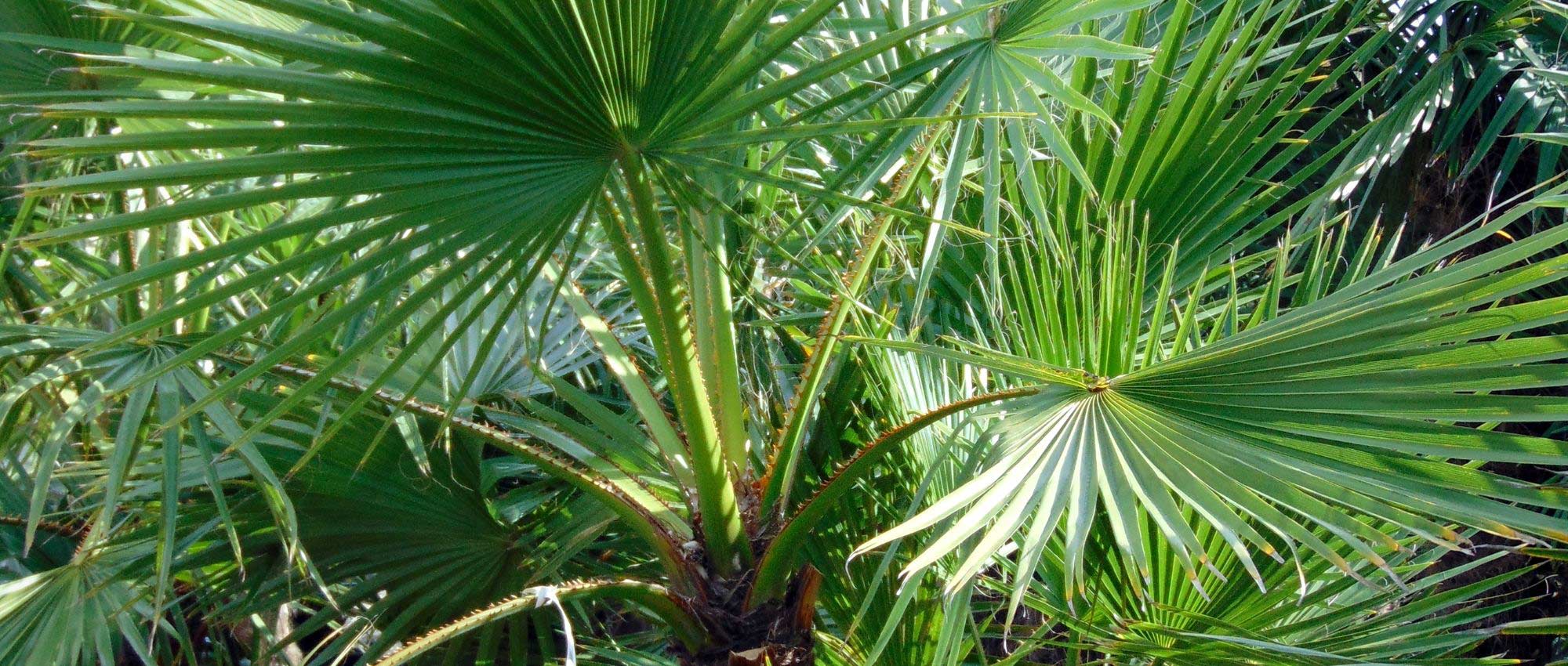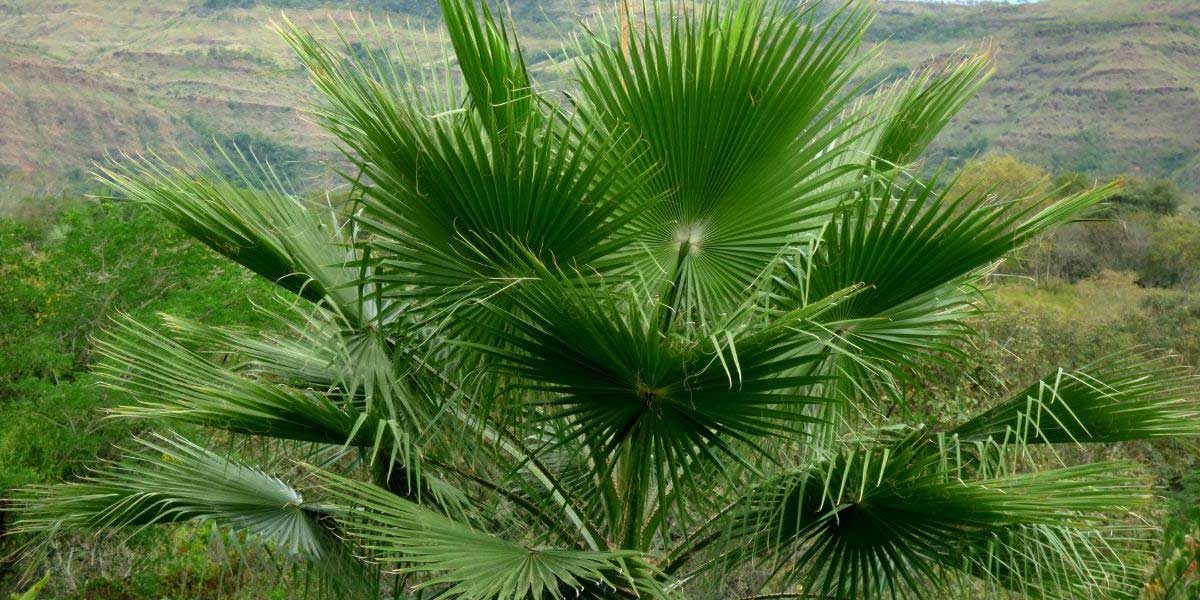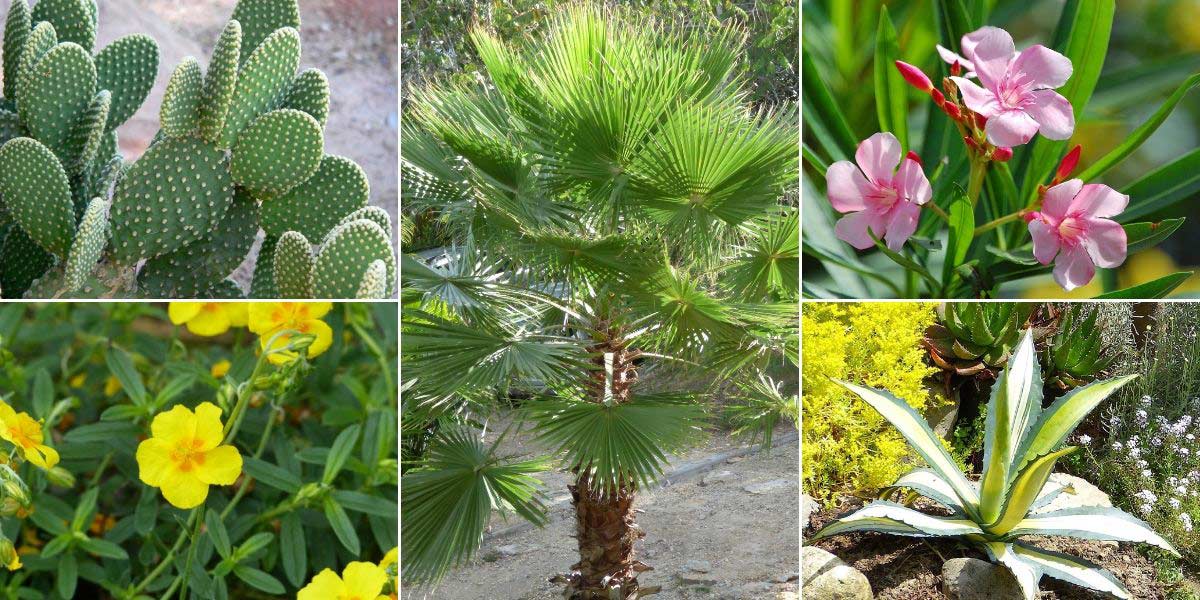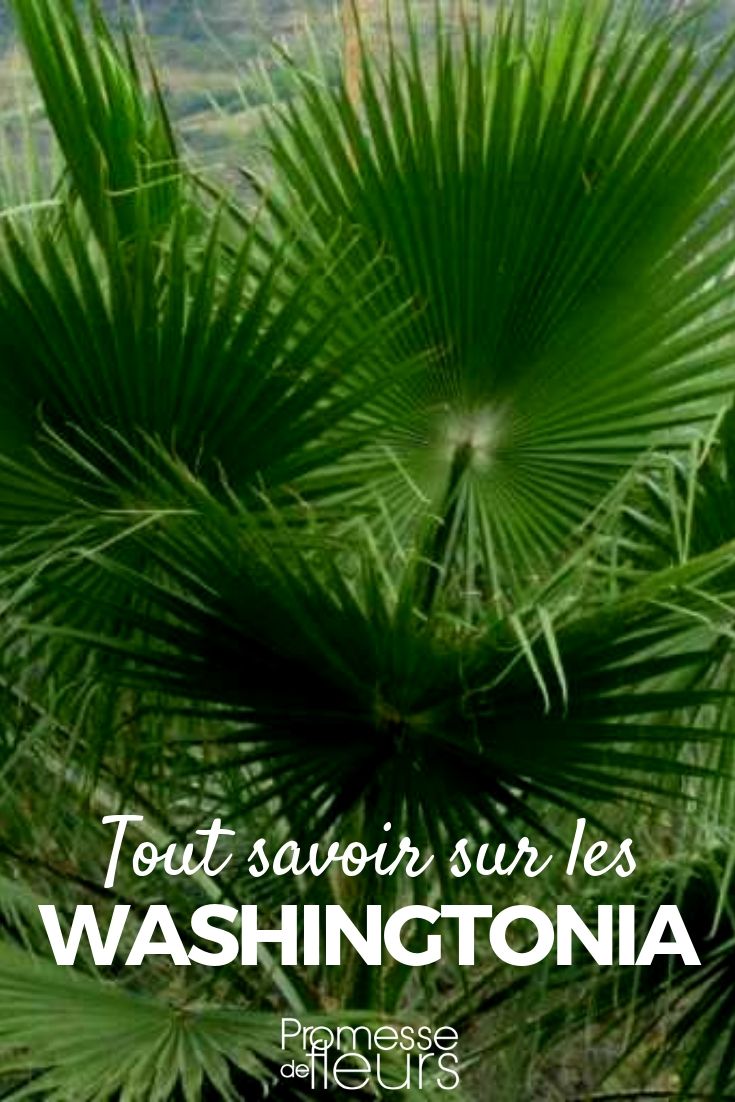
Washingtonia, Washington palm: planting, growing and care
Contents
Washingtonia in a nutshell
- Washingtonia is a large palm with an elegant habit
- It has a handsome, very straight vertical stipe topped by large palmate leaves borne on long petioles
- It has the advantage of growing faster than other palms!
- It is relatively hardy, tolerating −5°C, even −10°C
- Fairly easy to grow and undemanding, it thrives in full sun and sheltered from cold winds
- You can plant it on its own, in a clump with other palms, or in a row along an avenue
A word from our expert
Washingtonia is a palm native to southern California and northern Mexico. Also called “skirted washington palm” or “Mexican fan palm”, it has a massive, imposing trunk topped by a crown of large palmate leaves. The leaves bear small white fibres that detach. In summer, it produces huge inflorescences, often cream-coloured, made up of numerous small flowers. These are followed by small fruits, drupes that are brown–black at ripeness. There are two species: Washingtonia filifera and Washingtonia robusta, which can be confused. Over time these palms can become very large, reaching up to 20–25 metres in height.
Washingtonia is rather easy to grow and grows much faster than other palms. However, it is preferable to protect it in winter, unless you live in an area with a particularly mild climate, such as the Mediterranean basin. It can tolerate between −5 and −10 °C. In the garden, it will thrive in a sunny spot sheltered from cold winds, and in relatively well-draining soil. It is also possible to grow Washingtonia in a large container.
If you would like more information on palms in general and how to grow them, consult our sheet “Palms: planting, growing and maintenance”!
Description and botany
Botanical data
- Latin name Washingtonia sp.
- Family Arecaceae
- Common name Skirt palm, Mexican fan palm
- Flowering summer
- Height up to 20-25 m
- Exposure full sun
- Soil type ordinary, preferably well-drained and fertile
- Hardiness down to -5°C for W. robusta and -10°C for W. filifera
Washingtonia, also called Skirt palm, is a large palm with an imposing stipe and palmate foliage. It is native to southwestern United States (California, Arizona) and northwestern Mexico (Baja California, Sonora). It occurs in arid areas, mainly in gorges and canyons, sometimes near watercourses. Only two species exist: Washingtonia filifera and Washingtonia robusta, which are easily confused. An hybrid between these two species also exists: Washingtonia x filibusta.
Washingtonia is a palm and therefore belongs to family Arecaceae, which includes more than 2,500 species. Palms are impressive, highly structural plants in the garden. Their mere presence brings a strong exotic feel and creates a distinctive atmosphere. They have a characteristic silhouette, with a tall, very straight stipe from which a crown of leaves unfolds at the top, often of considerable spread, all attached directly to the stipe by a petiole.
Washingtonia owes its name to first United States president George Washington (1732–1799). In English this palm is nicknamed Sky duster. Species name filifera refers to long white threads that detach from the edges of the fronds.
Washingtonia grows very rapidly. It forms a single, obviously unbranched, stipe. It is very tall and straight, vertical, and can reach up to 80 cm in diameter. Palm stipes are formed by stacking the bases of the petioles and cannot really increase in diameter, only in height. If the top of the stipe is cut or dies, the entire palm will be doomed (unlike other trees and plants that can branch). The tallest Washingtonias reach 20–25 m in height. Washingtonia filifera has a stipe that is stouter, thicker and broader than Washingtonia robusta.

Stipe of a Washingtonia filifera (photo F. D. Richards), its leaves (photo Marija Gajić), and thorns covering petiole of a Washingtonia robusta (photo Forest and Kim Starr)
Washingtonia bears large, attractive palmate leaves. They are thick and rigid, with a lovely light green colour. They form a rounded outline but are cut into numerous plicate leaflets, long and narrow. Washingtonia leaflets bear long whitish threads (fibres that detach from leaflet edges), which gives Washingtonia filifera its species name. Leaves are borne on long petioles (up to 2 m), which are rimmed with orange-coloured teeth or thorns. Washingtonia robusta has broader, more pronounced and more aggressive thorns than Washingtonia filifera.
When old, leaves dry out and form a kind of skirt around the stipe beneath still-green leaves. This is why this palm is commonly called Skirt palm.
Bases of old leaf petioles remain in place for several years, then eventually fall away, revealing smooth brown bark.
Washingtonia flowers in summer, producing large inflorescences that can reach up to 4 m in length in Washingtonia filifera! They appear among the leaves at the same level and extend well beyond them. They are highly conspicuous and impressive. These are long, pendulous, ramified panicles made up of small cream-white flowers. Flowers are cream-white, tending towards pale yellow or light pink, and measure up to 1 cm in diameter. Flowers are tubular and consist of three petals, three sepals, six stamens and a style. Indeed, Washingtonia flowers are hermaphrodite: they bear both male organs (stamens) and female organs (pistil). Generally Washingtonia does not flower when grown indoors, only when planted in open ground. Likewise, flowering requires an adult-sized specimen; younger palms do not flower.
After flowering, Washingtonia produces numerous small rounded fruits that replace the flowers. These are drupes, brown–black in colour, measuring between 0.5 and 1 cm in diameter. Each fruit contains a single seed. A single Washingtonia plant is sufficient to produce viable seed. Fruits are edible and were used by Native Americans. They are also eaten by birds, which disperse the seeds after digesting the fruits.

Impressive flowering of Washingtonia, in panicles of cream-white flowers, and its fruits (photo Filo gèn’)
Main varieties

Washingtonia filifera - California Fan Palm
- Flowering time August, September
- Height at maturity 17 m

Washingtonia robusta - Mexican Fan Palm
- Flowering time August, September
- Height at maturity 24 m
Discover other Washingtonia
View all →Available in 1 sizes
Available in 4 sizes
Planting Washingtonia
Where to plant?
Washingtonia needs heat: plant it in full sun, in a spot sheltered from cold winds. It will do well in a free-draining substrate that does not retain too much moisture in winter. Washingtonia also appreciates soils rich in organic matter, fertile. Do not hesitate to add well-rotted compost from time to time. Likewise, Washingtonia prefers slightly calcareous ground.
Washingtonia is a large palm, with leaves and inflorescences that spread out: allow enough space for it to develop properly. Avoid planting it very close to a building, for example.
You can also grow it in a large container. This will allow you to bring it indoors in winter to protect it from cold, then put it back outside in spring when temperatures become milder. You can then place it on a terrace or in an inner courtyard, preferably in sun.
It is also possible to grow Washingtonia under a greenhouse or conservatory all year round. In that case, place it in a very bright spot, preferably without direct sun during the hottest hours.
Washingtonias make magnificent avenue trees, planted for example along a path.
When to plant?
Best time to plant Washingtonia is spring, in May or June. Temperatures become milder, which will improve establishment, and it can take advantage of summer to get off to a good start in its development before facing colder winter temperatures.
How to plant?
For planting in ground:
- Start by digging a large planting hole, which should be two to three times the volume of the rootball.
- Fill the bottom with soil mixed with a little well-rotted compost and, if needed, drainage materials: coarse sand, gravel…
- Plant your palm. Its collar must be at the same level as it was in the pot. Take care not to bury it, which could cause it to rot.
- You can create a watering basin by digging slightly around the stipe, to retain water from watering and help its infiltration to the base of the palm.
- Water generously.
Continue watering in the weeks that follow, until the palm is well established.
For planting in a pot:
- Choose a large pot or container. It must be pierced at the bottom to allow water to drain away.
- Place a drainage layer at the bottom, made of broken pots, clay pebbles or gravel. It will prevent water from stagnating at the base of the pot.
- Fill with potting compost mixed with garden soil and coarse sand.
- Plant your palm.
- Replace soil around and firm lightly.
- Water generously.
Place the pot in a sunny spot, sheltered from cold winds.

Washingtonia robusta (photo A. Bayer Tamayo)
Care
If you grow Washingtonia in the ground, water occasionally in spring and summer for the first few years. If grown in a pot, water more frequently, as the substrate tends to dry out quickly. Water mainly during the growth period, but reduce watering in autumn and winter.
Old leaves of Washingtonia dry out gradually and remain attached to the stipe, beneath the crown of green leaves. You may choose to cut away this skirt of dried leaves for aesthetic reasons, but we recommend leaving it in place.
If you grow Washingtonia in a pot, consider bringing it indoors in autumn to keep it in a frost-free, well-lit shelter, then put it outside again in spring. Acclimatise them gradually (especially when young): avoid placing them directly in full sun, but start by putting them out temporarily in partial shade and bring them indoors in the evening, before leaving them outside permanently. Also remember to repot, on average every two years, preferably in spring. If grown in a pot, you can apply liquid fertiliser.
In winter, during the first few years, we advise protecting your palms from the cold by wrapping them in several layers of winter fleece, and by laying a thick mulch around their base. They will become more cold-hardy as they age.
Diseases and parasitic pests of Washingtonia
Washingtonias are sometimes attacked by the palm moth, Paysandisia archon. The larva of this lepidopteran native to South America bores galleries and consumes the palm stipe. New leaves that emerge are deformed, perforated and dry out. You may also notice sawdust, cocoons, gallery entrance holes with viscous gum at the entrance. You can spray a nematode-based solution that parasitises these larvae. Don’t hesitate to call in a professional.
To learn more, read our article : “The palm moth, Paysandisia archon: control and treatment”
You may also encounter problems with the red palm weevil, Rhynchophorus ferrugineus. This is a beetle native to Asia, red and black in colour, about 3 cm long. It attacks the heart of the palm, causing central fronds to fall. The crown of leaves becomes bare and collapses. If nothing is done, the palm may die. Nematodes, or a pathogenous fungus (Beauveria bassiana), can be used against the weevil. If you have other palms, protect them to prevent weevil or palm moth attacks.

Palm moth (photo Daniel Villafruela) and red palm weevil (photo Katja Schulz)
When grown indoors, Washingtonias can be attacked by scale insects. In that case, you can use black soap to get rid of them. They may also be targeted by red spider mites, tiny mites that pierce the foliage and extract sap. Mist your palm, as red spider mites dislike humidity.
Propagation by sowing
You can obtain new young plants of Washingtonia by sowing the seeds. The sowing is done in spring.
- Begin by placing the seeds in hot water for 24 hours.
- Prepare a pot with potting compost mixed with a little coarse sand.
- Remove the seeds from the water and sow them.
- Cover with a thin layer of substrate.
- Water gently.
- Keep the pot at about 25 °C in a bright place but out of direct sunlight.
Germination of Washingtonia is fairly quick (within 1 to 2 months, or even less when seeds are still fresh), compared with other palms. Once seedlings are large enough, you can pot them on into individual pots.
Association
Washingtonia is an imposing palm; its mere presence is ideal for recreating an exotic, luxuriant atmosphere. Plant other plants with generous, deep green, well-developed foliage alongside it. Choose, for example, arborescent ferns, other palms, Tetrapanax, Persicaria polymorpha, bamboos… You can also include some climbers, such as Akebia quinata, bignonias or passionflowers. At pond edge, consider Gunneras and osmundas.
You can also use Washingtonia to create a Mediterranean-style garden, with plants adapted to drought and full sun. Choose, for example, santolinas, lavenders, cistus, Phormium, Yuccas and Opuntias… Also take advantage of Senecio cineraria, valued for its elegant, finely cut, silvery foliage. If you wish to include some trees, consider Mimosa or Lagerstroemia. As a hedge or as an isolated specimen, you can include Oleander, Nerium oleander, which will charm with both its foliage and its generous flowering.

Washingtonia fits easily into Mediterranean-style garden! From left to right: Opuntia microdasys (photo Stan Shebs), Helianthemum ‘Ben Fhada’, Washingtonia robusta (photo Alejandro Bayer Tamayo), Nerium oleander (photo Challiyan), and Agave mediopicta ‘Lutea’
Finally, Washingtonia also fits easily into a modern, graphic-style garden. Plant it in a large, designer pot that you can place on your terrace or in a patio, for example. It will pair nicely with agapanthus, ornamental grasses, Alliums, Eremurus, Ophiopogon, ferns… Include structural plants that draw the eye and add height. Play with lines by introducing vertical elements and laying out very straight paths to contrast with curved shapes. Stick to very restrained colours: purple, chocolate, black, white… You will achieve a timeless effect, a garden both chic and timeless.
Useful resources
- Discover our Washingtonias as well as our full range of palms
- Our article: Palms by climate
- Discover our tutorial: How to dry a palm leaf?
- To prevent and treat: Diseases and parasitic pests of palms
Frequently asked questions
-
How to tell Washingtonia robusta from Washingtonia filifera?
These two species look very similar, but a few details allow them to be distinguished. In Washingtonia robusta, underside of leaves shows a white spot in the centre. On the petiole, the teeth are broader and hooked, more aggressive (with a brown–orange tinge), whereas in W. filifera they are small and fine. Likewise, Washingtonia filifera has a longer petiole (up to 2 m), longer inflorescences (up to 4 m), and a stipe that is stouter and broader, creating a very imposing effect (while W. robusta is more slender and fine). Finally, leaves of Washingtonia filifera are more deeply divided.
-
Crown of leaves is drooping. What's happening?
Your Washingtonia is probably being attacked by the palm moth or the red palm weevil. Check for other signs that would confirm their presence: sawdust, boreholes, cocoons, perforated leaves... If so, we recommend spraying a nematode-based solution that will parasitise them. Don’t hesitate to call in a professional.
-
Why do the leaves on my Washingtonia have holes?
If leaves show neatly aligned holes, your Washingtonia has probably been attacked by the palm moth, Paysandisia archon. This pest causes significant damage by feeding on the heart of the stipe. You can treat it with nematodes (Steinernema carpocapsae) or use a sticky barrier to prevent adults from laying their eggs on the palm.
-
Should I prune the dead leaves that remain attached to the stipe?
Washingtonia leaves renew over time, and older leaves eventually dry out but remain attached to the stipe, forming a "skirt" beneath the crown of green leaves. You can cut them for aesthetic reasons, but we recommend leaving them in place. They provide some protection to the palm against external damage and cold.
- Subscribe!
- Contents


































Comments